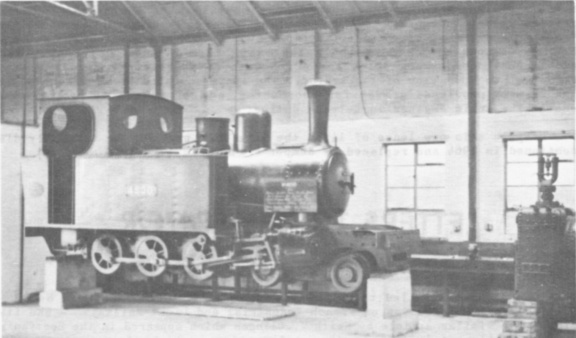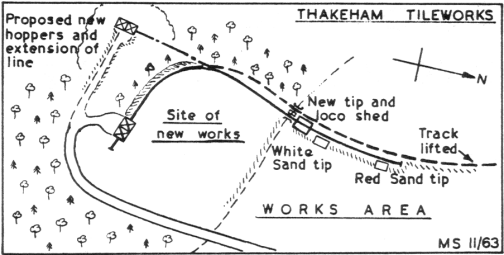
| THE INDUSTRIAL RAILWAY RECORD |
© DECEMBER 1963 |
LETTERS TO THE EDITOR
I regret that I failed to acknowledge that my article in RECORD No.2 - "British Steam Locomotives on French Industrial and Light Railways" - had its origin in a similar article by Keith W. Clingan which appeared in the Section‘s Bulletin 24 (August 1954). Further information is to hand on Peckett 1600 which was sold by the Cie. Nationale des Radiateurs in 1951 to Ets. Bonnet-Baudin of St. Amand les Eaux, Nord; after repair it was sold straightaway to the Sucrerie Co−operative de Lillers, Lillers, Pas de Calais. Hudswell Clarke 811 was cut up about 1960.
On the Chemin de Fer de Wendel (RECORD No.1) more than thirty steam locomotives were noted in use in July 1963, but it appears that the Baldwin 2−8−0’s have been replaced by diesels.
Visitors this year to Pithiviers (RECORD No.2) write of the scrapping of two Mallets, two 0−10−0T‘s and an Alco 2−6−2T, but two Franco-Belge 0−8−0T‘s have been obtained from the Sucrerie Ternyck at Coucy le Château. The Hunslet 4−6−0T was lying derelict at Toury, where the sugar factory system appears to have closed recently.
Yours etc.,
| WATFORD, HERTS. |
N. A. NEEDLE. |
I found the article on "3240" in RECORD No.1 most interesting, but the inference that 3240, scrapped at Jee’s Quarries in 1948, was the last example in this country is not quite correct. In fact 3239 was the final British representative, having survived in the fitters’ school on the Longmoor Military Railway until about July 1961, when it was scrapped on site by W. H. Arnott, Young & Co. Ltd.

For some unknown reason this locomotive was renumbered 4530 at Longmoor, supposedly about 1952, but I know nothing else of its history. I did, however, manage an interior photograph in July 1953; as can be seen, 4530 is in more or less original condition, the only visible alterations being the Perspex panels in the cylinder wall and valve chest. These were put in so that the movement of the piston and valves could be seen by fitters receiving instruction in the principles of Walschaerts valve gear. (I presume that the wheels were turned by "volunteers".)
Perhaps a reader could shed some light on the activities of 3239 (alias 4530) during the 1919-1952 period?
Yours etc.,
| HILLINGDON, MIDDLESEX. |
P. ROBERTS. |
Dear Sir,
I revisited the above during August 1963 and found that the position had changed somewhat since I wrote the article appearing in RECORD No.2.
The wintry weather early in 1963 completely halted production for Hall & Co. Ltd. were unable to dig sand, and Thakeham similarly was unable to produce bricks, even if anyone could have used them. After the initial rush of orders when the thaw came, it was found that orders were coming in at a greater rate than ever before. The railway was brought out of its enforced hibernation and the works continued at full pressure. It was realised in mid−March that existing manufacturing facilities would soon be inadequate, and that expansion would soon have to occur. Consequently, the idea of a conveyor belt was dropped, and it was decided to alter the railway with a view to keeping it going.

Towards the end of March, therefore, several improvements were made. The locomotive shed and line down to it were completely removed and, on the siding, the white sand tip was moved nearer to the footpath. As the old bridge over this path was becoming unsafe a new one was built adjacent to it and, to minimise vibration the track laid on rubber pads. What was the siding became part of the "main line", and thus the total track length was halved. The main innovation was one which altered the character of the line, for the entire hillside between the footpath and the railway cutting was removed and the earth levelled. (On this space it is proposed to make another brickmaking shed.) The earth from this operation was transferred to the old sandpit to form the basis of a new approach road to another proposed set of hoppers. When these are built the original hoppers will serve the new brickmaking shed, and the track relaid so that the new hoppers serve the original sheds.
The red sand tip is unaltered but, as previously mentioned, the white sand tip has been moved. A brick shed is under construction to house the new tip; it will also serve as a locomotive shed. »
Yours etc.,
| NEW MALDEN, SURREY. |
C. G. DOWN. |
Concerning the article on "The Boume Valley Tramway" in RECORD No.1, I recently came across a description of the Dorset Potteries in the ‘Taunton Journal" of 8th May 1856, quoting from "The Builder". In 1856 there were six potteries at Poole, those at Boume Valley being the first in the area where drainpipes were successfully made. The firm commenced operations on 3rd March 1853 and burnt their first kiln in June of that year. The first pit on the site was started in September 1852 and the works was impelled by steam power", but this referred to a stationary engine and no mention is made of a tramway.
Yours etc.,
|
YEOVIL, SOMERSET. |
M.J. O‘CONNOR. |